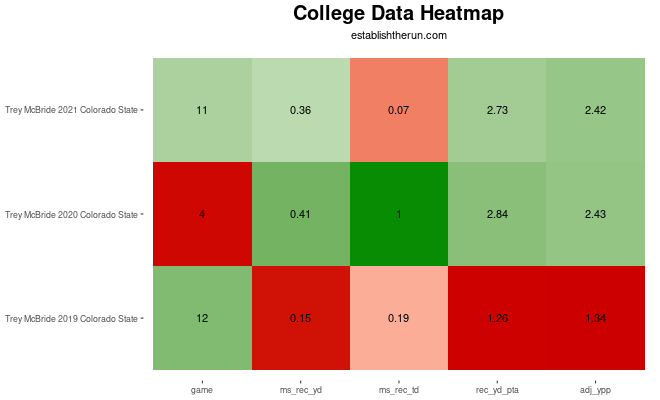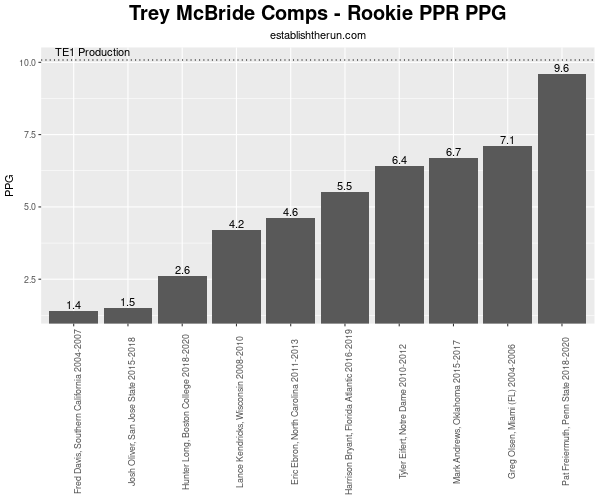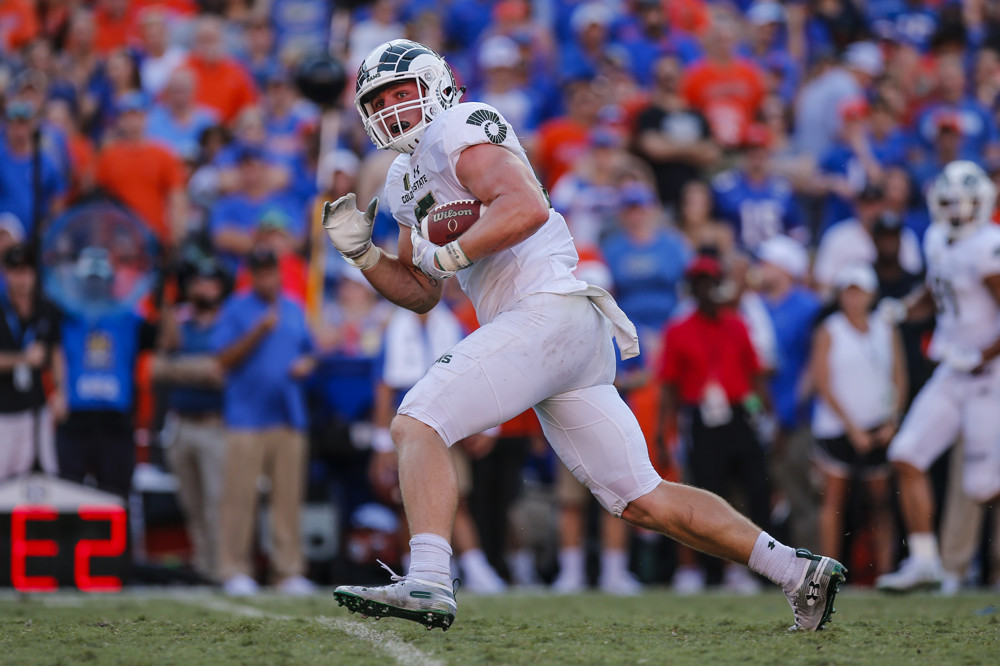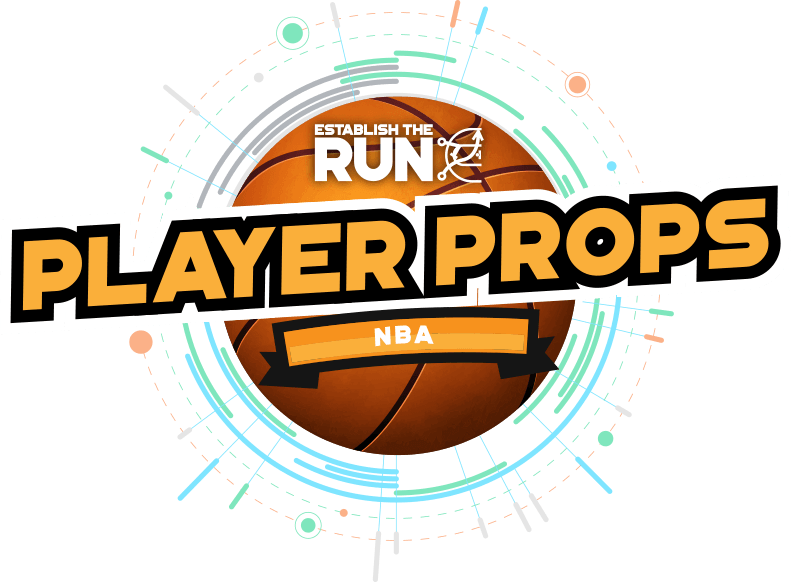Dynasty Outlook
April 4
Trey McBride is currently our top TE for rookie drafts, and is the TE15 in our overall dynasty ranks. In Superflex/TE premium formats, we like him as a mid-second-round selection for rookie drafts. McBride displayed the ability to absorb volume when it was fed his way while at Colorado State, which makes him a great target in formats that award additional points for TEs. Even in more standard formats, McBride is the kind of pass catcher who could ascend at the position. His comps are littered with TE1 talents, and this year’s rookie class falls off quickly in terms of “sure things”. McBride’s ability to block should get him on the field right away.
Profile Summary
McBride is a quality two-way TE prospect, and should come off the board at some point on Day 2 of the NFL Draft. His production was some of the best we’ve seen in recent college football history, though the scouts do not believe his athleticism is quite as good as was timed at his pro day. McBride has large hands, and has the potential to be a key cog in someone’s passing game, though it is unlikely he is the main focal point as he was at Colorado State. Winning the Mackey Award puts McBride in good company, and that is further enforced by his statistical comps.
Vitals
Age (as of 12/31/21) — 22.1
Experience — 4 years
Height — 75.625 inches
Weight — 246 pounds
Hand Size — 10.125 inches
Arm Length — 32.5 inches
Wingspan — 78.625 inches
Forty — 4.58 seconds (pro day)
Bench — 18 reps
Vertical — 33 inches
Broad — 117 inches
By the Numbers

McBride was a fantastic producer while at Colorado State. To start his career, he had to compete with NFL WR Preston Williams, but by Year 3, he was the main cog in the offense. It is fair to wonder if McBride would have left school after the 2021 season had the Rams been able to play more than four games due to COVID. He had accounted for 41% of the team’s receiving yards, and caught all of their TDs (4).
Returning ended up working out fine for McBride. He caught 90 balls for over 1,100 yards — more than double the output of any other player on the team. This kind of prolific production led to McBride winning the Mother Fucking Mackey. For context, his 2.42 adjusted yards per play in 2021 was on par with Ohio State WR Chris Olave. It is the seventh-highest number in our TE database.
What the Scouts are Saying
Daniel Jeremiah mentioned McBride in his first big board of the season:
McBride is a big, physical tight end with outstanding hands. He lines up attached, in the slot, on the wing, or split out wide. Colorado State’s entire passing offense was centered around him. He isn’t an explosive athlete, but he’s an efficient route runner who does a nice job walling off defenders and making contested catches. He tracks very naturally down the field and has made some spectacular one-handed grabs. He’s also very flexible to adjust to low balls and back-hip throws. After the catch, he is very physical and competitive to fight for extra yards. He’s an excellent in-line blocker in the run game. He latches on, runs his feet, and finishes. Overall, McBride doesn’t have elite speed, but he’s extremely reliable in every facet of the position.
Lance Zierlein backs Jeremiah’s mention of a lack of top-end speed, but notes other strengths:
Two-way tight end with the size, strength, and ball skills to help impact games in-line and in space. McBride has room for improvement at the point of attack, but possesses the thickness and determination of a true, in-line blocker. He’ll need to improve his angles and play strength to even out the wins and losses against NFL competition. McBride lacks top-end speed and quickness into the route, but he can snap off route breaks and has the body control and sticky hands to win contested-catch battles. Long athletes could suffocate his catch space if he doesn’t play with more physicality and aggression during the route. McBride is solid in all phases and should appeal to every team looking for a combination tight end with early starting potential.
Draft Projection
McBride currently has an expected draft position of 47.9 on Grinding the Mocks, which sources mock drafts around the interwebs. NFL Mock Draft Database, a similar service, has him 58th overall. After an impressive showing at his pro day, McBride appears to be a likely Day 2 pick, coming off the board as early as mid-Round 2.
Comparable Players
I use Principal Component Analysis to evaluate TE prospects. In simplest terms, this kind of analysis looks at relevant data points to find the closest comparable QBs in past drafts. I prefer this to a model output — which yields only a single result — as it can display the possible range of outcomes for a prospect.
Note that the analysis itself isn’t telling us how good a player is; it is simply returning the most similar players. It is then up to us to layer in context and past results to see how good we think this player may be.

McBride comps to some fellow Mackey Award winners — Mark Andrews, Tyler Eifert, Fred Davis, and Harrison Bryant. These prospects had mixed levels of success, but it is notable that only Bryant was taken outside of the top 100 picks — and not by much (115). We also get a great look at McBride’s potential ceiling with the Andrews and Eifert comps. Both players have been high-end TE1s in the past.
Of the 10 players listed here, five have posted at least one TE1 season, while three were recent draft picks. The only two outright busts were Josh Oliver and Lance Kendricks. It is notable that McBride’s most comparable player (Andrews) comes in at just 76% similar. His prolific production and quality 40 time make McBride a unique prospect.



